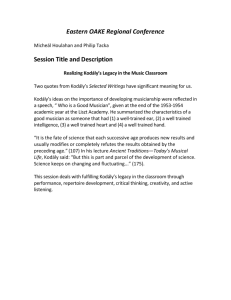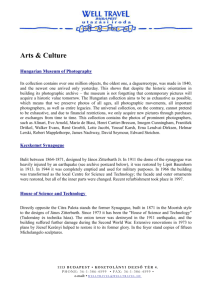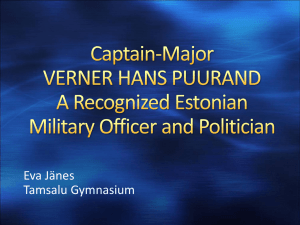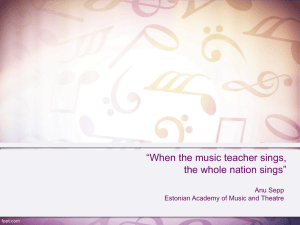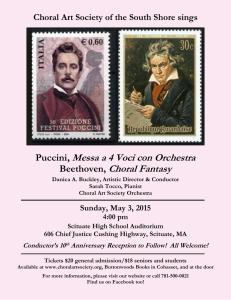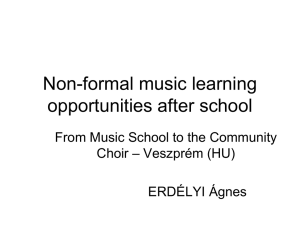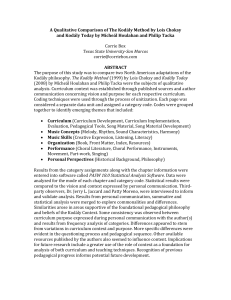the presentation
advertisement
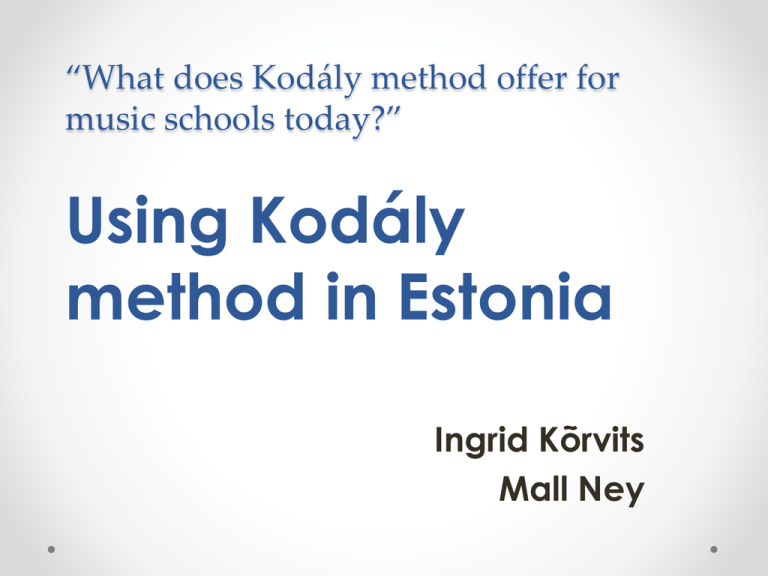
“What does Kodály method offer for music schools today?” Using Kodály method in Estonia Ingrid Kõrvits Mall Ney ESTONIA Northern Europe, independent since 1918, 45 000 km2,, population 1,3 million, language Estonian (fenno ugric) The beginnings of using the Kodály method in Estonia • 1962 – Estonian composer Veljo Tormis at Zoltan Kodály’s 80th birthday celebrations in Budapest • 1964 – Estonian composer and music teacher Riho Päts gives a presentation in the 6th ISME conference in Budapest • Heino Kaljuste and other Estonian music teachers and conductors participating in the same Budapest conference Riho Päts (1899–1977) Heino Kaljuste (1925–1989) Veljo Tormis (1930) Role of Heino Kaljuste in presenting and implementing Kodály method in Estonia since 1964 • • • • • • • • • • 1951 – founding of children’s choir Ellerhein 1962 – 1st Song Celebration for schoolchildren in Tallinn 1964 – Heino Kaljuste in the 6th ISME conference in Budapest 1964 – 1st musically oriented class in a public school (1st grade) 1965 – 1st song- and textbook for a musically oriented classroom (1st grade) 1967 – transition to the JO-LE-MI system in public school classrooms 1968 – the 1st “JO-LE-MI” manual for music teachers 1969 – 1st song- and textbook for an ordinary (non-music focused) classrooms, co-author Riho Päts Numerous articles, publications, open workshops about the essence and necessity of the JO-LE-MI system 1969-1989 as professor Musical Education in the Estonian Music Academy JO-LE-MI table Kodály method in schools (according to the curriculum) School system: • Primary school (1st-4th grade), music classes twice a week + choral singing (voluntare) • Basic school (5th-9th grade), music class once a week + choral singing (voluntare) • High school (10th-12th grade), music history once a week + choral singing (voluntare) Using Kodály method in music schools (with instrument studies) Music school (7 years + 2 additional years) • Instrument lessons twice a week • Solfeggio classes twice a week • Music history once a week • Ensembles once a week Tallinn Music High School (12 years) • Instrument lessons 2-3 times a week • Solfeggio twice a week • Rythmics once a week • Music history 2-4 times a week • Choirs and orchestras twice a week • Classes of piano accompany, ensemble and music theory once or twice a week Using Kodaly method in a modern school of hobbies/choir studio Mostly: • Choir practice 4-6 hours a week • Solfeggio 30 minutes to an hour a week • Vocal coaching 30 minutes to an hour a week Estonian National Opera Boys’ Choir • Founded in 1971 by professor Venno Laul • Since 2001 Hirvo Surva as leader and artistic director • A choral studio with three different levels: the main choir and two study choirs • Ca. 150 young singers • Performed in Puccini´s “Tosca“ and “La boheme”, Bizet´s “Carmen”, Wagner`s “Tannhäuser“, “The Nutcracker“ by Tchaikovsky, etc. Girls' Choir Ellerhein • Founded in 1951 by professor Heino Kaljuste (1925–1989) • A choral studio with three different levels: two children's choirs and a girls' choir • Ca. 200 singers • Chief conductor 1989–2012 Tiia-Ester Loitme, since 2012 Ingrid Kõrvits • Ca. 30 performances every year • Over 30 prizes in international choral competitions • 2004 the Grammy Award for Jean Sibelius “Cantatas” with Estonian National Male Choir and Estonian National Symphony Orchestra – conductor Paavo Järvi Estonian Song Celebrations • 1st Song Celebration in 1869 • Since 1910 until today Song Celebrations mostly in every 5 years • 1st Song Celebration of schoolchildren in 1962, also occur every 5 years • Up to 30 000 singers singing at the same time, the audience is up to 100 000 people • Next Song Celebration “Touch of Time. Time for a Touch” 4-6th of July 2014 Thank you! Ingrid Kõrvits Mall Ney
